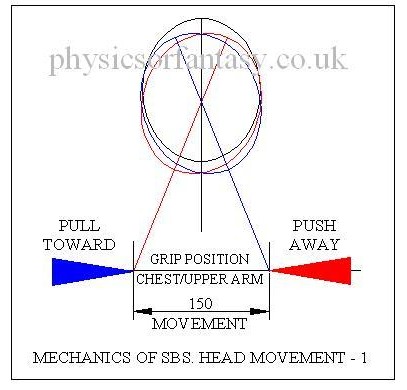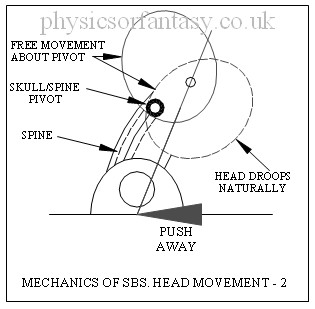Mechanics of the Shaken Baby Syndrome
Posted on January 19th, 2016
Brian
The following drawing shows the basic mechanics relating to shaking a baby. Surprisingly, the total shaking movement of the child’s body, to and fro, is only about 6″ (150mm). Just try it and see, (but not on a real child, please) and you will find it difficult and uncomfortable to make it more than that. You should also realise that it’s the child’s body that is shaken, not it’s head.

As the head is not rigidly fixed to the body it does not move this same 6″ but moves up and down by a few millimetres and also rotates by about 20º each side of the vertical, the neck bending to allow this to happen. There are only small acceleration forces acting on the head. Basically, the body moves relative to an almost stationary head
The inertia of the child’s head restricts any rapid movements to it. Any movements of the head can only be caused by forces acting through the neck, which is very flexible. Any serious movements to the head would cause serious damage to the spine which is just as fragile as the brain.
The following drawing refers to the auxiliary head movements that should also be considered.

The relatively free ‘nodding’ movement of the head is entirely consciously controlled by muscles in the neck. If you fall asleep your head will freely fall backwards, sideways or forward. Undue accelerations in this movement would likely cause neck muscle and tendon damage plus damage to the complex pivot assembly because in the SBS case the child is assumed to be awake. However, these same injuries could also happen during the birth process.
I sent data to the Louise Woodward defence team relating to the mechanics of Shaken Baby Syndrome in 1997.
Anyone who watched the case on television, after the defence team brought in a specialist engineer, must have been amazed by the prosecution attorney’s ridiculous antics whilst attempting to show how the head could be held in such a way that it was shaken along with the body. She had obviously spent a lot of time thinking about this, but the contortions she got into made it obvious that Louise Woodward could never have carried out the same rigmarole in a fit of anger.
———————————–
Abstract.
Dynamic Biomechanical Findings on Shaken Baby Syndrome/Lethal Minor Falls
http://sbsreferences.com/DownloadHandler.ashx?pg=392f9051-f6fa-4a54-a2d8-70157cf253c0§ion=11dab90f-171c-4263-9334-b175c406f533&file=Exhibit+14A.pdf
FROM: Injury Biomechanics Researcher: Chris Van Ee, PhD
TO: The Honorable Court
SUBJECT: Dynamic Biomechanical Findings on SBS-LMF
DATE: March 3, 2008
Dynamic Biomechanical Findings March 7, 2008 Page 2 of 4
2. SBS/LMF Findings From Biomechanical Tests and Studies:
(A) Scientific testing has shown that head acceleration levels from anterior/posterior human shaking of a normal 0- to 2-year-old child in the sagittal plane results in head acceleration and force levels that are much lower than those which are associated with traumatic head injury. Repeated testing of this hypothetical has shown that the head accelerations associated with shaking are far below the level associated with injury and there is no quality data to support the SBS brain injury mechanism. Thus shaking, even if done in a fit of anger, is not expected to result in head dynamics sufficient to cause direct intracerebral trauma.
(B) Human shaking (id.) may cause lethal brain stem and cervical spine injuries in a 0-to 2-year-old child, as the forces necessary for these injuries are well below the level needed for fatal brain injuries and are consistent with the forces that can be produced in shaking. Put another way, these neck injuries would be expected in any hypothetical-superhuman-strength case of SBS where superhuman dynamics resulted in head accelerations leading to intercerebral trauma (if SBS were valid, which it is not).
————————————–
Abstract from
Shaken baby syndrome: A biomechanics analysis of injury mechanisms.
Traumatic infant shaking has been associated with the shaken baby syndrome (SBS) diagnosis without verification of the operative mechanisms of injury. Intensities for SBS have been expressed only in qualitative, unsubstantiated terms usually referring to acceleration/deceleration rotational injury and relating to falls from great heights onto hard surfaces or from severe motor vehicle crashes. We conducted an injury biomechanics analysis of the reported SBS levels of rotational velocity and acceleration of the head for their injury effects on the infant head-neck. Resulting forces were compared with experimental data on the structural failure limits of the cervical spine in several animal models as well as human neonate cadaver models. We have determined that an infant head subjected to the levels of rotational velocity and acceleration called for in the SBS literature, would experience forces on the infant neck far exceeding the limits for structural failure of the cervical spine. Furthermore, shaking cervical spine injury can occur at much lower levels of head velocity and acceleration than those reported for the SBS. These findings are consistent with the physical laws of injury biomechanics as well as our collective understanding of the fragile infant cervical spine from (1) clinical obstetric experience, (2) automotive medicine and crash safety experience, and (3) common parental experience. The findings are not, however, consistent with the current clinical SBS experience and are in stark contradiction with the reported rarity of cervical spine injury in children diagnosed with SBS. In light of the implications of these findings on child protection and their social and medico-legal significance, a re-evaluation of the current diagnostic criteria for the SBS and its application is suggested.
Faris A. Bandak. Department of Neurology, A1036 F. Edward Hébert School of Medicine, Uniformed Services, University of the Health Sciences, Bethesda, MD 20814, USA
—————————-
Abstract from Wikapedia/cheshire nanny case (Louise Woodward Trial. 1967)
Patrick Barnes, a pediatric radiologist at Stanford University, was a key prosecution witness in the trial, but in 2011 said he would not give the same testimony today. He said there had been a revolution in the understanding of head injuries in the past decade, partly due to advances in MRI brain scanning technology: “We started realizing there were a number of medical conditions that can affect a baby’s brain and look like the findings that we used to attribute to shaken baby syndrome or child abuse”, such as infections and in utero strokes.
—————————-
MORE TO FOLLOW SHORTLY.
Author – Brian Williams
Read also; Shaken Baby Syndrome-Debunking the Myth
Shaken baby syndrome: A biomechanics analysis of injury mechanisms
Leave a reply



